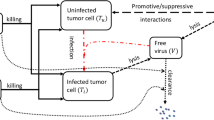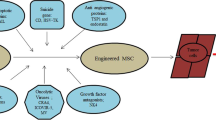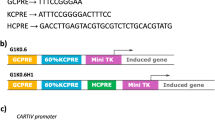Abstract
Tumor microenvironment is composed of different cell types including immune cells. Far from acting to eradicate cancer cells, these bone marrow-derived components could be involved in carcinogenesis and/or tumor invasion and metastasis. Here, we describe an alternative approach to treat solid tumors based on the genetic modification of hematopoietic stem and progenitor cells with lentiviral vectors. To achieve transgene expression in derivative tumor infiltrating leukocytes and to try to decrease systemic toxicity, we used the stress inducible human HSP70B promoter. Functionality of the promoter was characterized in vitro using hyperthermia. Antitumor efficacy was assessed by ex vivo genetic modification of lineage-negative cells with lentiviral vectors encoding the dominant-negative mutant of the human transforming growth factor-β receptor II (TβRIIDN) driven by the HSP70B promoter, and reinfusion of cells into recipient mice. Subsequently, syngeneic GL261 glioma cells were subcutaneously injected into bone marrow-transplanted mice. As a result, a massive antitumor response was observed in mice harboring TβRIIDN under the HSP70B promoter, without the need of any external source of stress. In summary, this study shows that stem cell-based gene therapy in combination with spatial and temporal control of transgene expression in derivative tumor-infiltrating cells represents an alternative strategy for the development of novel antitumor therapies.
This is a preview of subscription content, access via your institution
Access options
Subscribe to this journal
Receive 12 print issues and online access
$259.00 per year
only $21.58 per issue
Buy this article
- Purchase on Springer Link
- Instant access to full article PDF
Prices may be subject to local taxes which are calculated during checkout






Similar content being viewed by others
References
Gervois N, Guilloux Y, Diez E, Jotereau F . Suboptimal activation of melanoma infiltrating lymphocytes (TIL) due to low avidity of TCR/MHC-tumor peptide interactions. J Exp Med 1996; 183: 2403–2407.
Restifo NP . Not so Fas: re-evaluating the mechanisms of immune privilege and tumor escape. Nat Med 2000; 6: 493–495.
Derynck R, Akhurst RJ . Differentiation plasticity regulated by TGF-beta family proteins in development and disease. Nat Cell Biol 2007; 9: 1000–1004.
Anderson PM, Katsanis E, Leonard AS, Schow D, Loeffler CM, Goldstein MB et al. Increased local antitumor effects of interleukin 2 liposomes in mice with MCA-106 sarcoma pulmonary metastases. Cancer Res 1990; 50: 1853–1856.
Vaage J . Peri-tumor interleukin-2 causes systemic therapeutic effect via interferon-gamma induction. Int J Cancer 1991; 49: 598–600.
White RL, Schwartzentruber DJ, Guleria A, MacFarlane MP, White DE, Tucker E et al. Cardiopulmonary toxicity of treatment with high dose interleukin-2 in 199 consecutive patients with metastatic melanoma or renal cell carcinoma. Cancer 1994; 74: 3212–3222.
Havell EA, Fiers W, North RJ . The antitumor function of tumor necrosis factor (TNF), I. Therapeutic action of TNF against an established murine sarcoma is indirect, immunologically dependent, and limited by severe toxicity. J Exp Med 1988; 167: 1067–1085.
Anton M, Gomaa IE, von Lukowicz T, Molls M, Gansbacher B, Würschmidt F . Optimization of radiation controlled gene expression by adenoviral vectors in vitro. Cancer Gene Ther 2005; 7: 640–646.
Loew R, Heinz N, Hampf M, Bujard H, Gossen M . Improved Tet-responsive promoters with minimized background expression. BMC Biotechnol 2010; 10: 81.
Chyung YH, Peng PD, Kay MA . System for simultaneous tissue-specific and disease-specific regulation of therapeutic gene expression. Hum Gene Ther 2003; 14: 1255–1264.
Frecha C, Szécsi J, Cosset FL, Verhoeyen E . Strategies for targeting lentiviral vectors. Curr Gene Ther 2008; 8: 449–460.
Shah AH, Tabayoyong WB, Kundu SD, Kim SJ, Van Parijs L, Liu VC et al. Suppression of tumor metastasis by blockade of transforming growth factor beta signaling in bone marrow cells through a retroviral-mediated gene therapy in mice. Cancer Res 2002; 62: 7135–7138.
Gorelik L, Flavell RA . Abrogation of TGF beta signaling in T cells leads to spontaneous T cell differentiation and autoimmune disease. Immunity 2000; 12: 171–181.
Shah AH, Tabayoyong WB, Kimm SY, Kim SJ, Van Parijs L, Lee C . Reconstitution of lethally irradiated adult mice with dominant negative TGF-beta type II receptor-transduced bone marrow leads to myeloid expansion and inflammatory disease. J Immunol 2002; 169: 3485–3491.
Borrelli MJ, Schoenherr DM, Wong A, Bernock LJ, Corry PM . Heat-activated transgene expression from adenovirus vectors infected into human prostate cancer cells. Cancer Res 2001; 61: 1113–1121.
Li GC, He F, Shao X, Urano M, Shen L, Kim D et al. Adenovirus-mediated heat-activated antisense Ku70 expression radiosensitizes tumor cells in vitro and in vivo. Cancer Res 2003; 63: 3268–3274.
Vekris A, Maurange C, Moonen C, Mazurier F, De Verneuil H, Canioni P et al. Control of transgene expression using local hyperthermia in combination with a heat-sensitive promoter. J Gene Med 2000; 2: 89–96.
Ito A, Tanaka K, Kondo K, Shinkai M, Honda H, Matsumoto K et al. Tumor regression by combined immunotherapy and hyperthermia using magnetic nanoparticles in an experimental subcutaneous murine melanoma. Cancer Sci 2003; 94: 308–313.
Liu Y, Kon T, Li C, Zhong P . High intensity focused ultrasound-induced gene activation in solid tumors. J Acoust Soc Am 2006; 120: 492–501.
Schambach A, Bohne J, Chandra S, Will E, Margison GP, Williams DA et al. Equal potency of gammaretroviral and lentiviral SIN vectors for expression of O6-methylguanine–DNA methyltransferase in hematopoietic cells. Mol Ther 2006; 13: 391–400.
Gerner EW, Hersh EM, Pennington M, Tsang TC, Harris D, Vasanwala F et al. Heat-inducible vectors for use in gene therapy. Int J Hyperthermia 2000; 16: 171–181.
Huang Q, Hu JK, Lohr F, Zhang L, Braun R, Lanzen J et al. Heat-induced gene expression as a novel targeted cancer gene therapy strategy. Cancer Res 2000; 60: 3435–3439.
Smith RC, Machluf M, Bromley P, Atala A, Walsh K . Spatial and temporal control of transgene expression through ultrasound-mediated induction of the heat shock protein 70B promoter in vivo. Hum Gene Ther 2002; 13: 697–706.
Xu L, Zhao Y, Zhang Q, Li Y, Xu Y . Regulation of transgene expression in muscles by ultrasound-mediated hyperthermia. Gene Ther 2004; 11: 894–900.
Silcox CE, Smith RC, King R, McDannold N, Bromley P, Walsh K et al. MRI-guided ultrasonic heating allows spatial control of exogenous luciferase in canine prostate. Ultrasound Med Biol 2005; 31: 965–970.
Plathow C, Lohr F, Divkovic G, Rademaker G, Farhan N, Peschke P et al. Focal gene induction in the liver of rats by a heat-inducible promoter using focused ultrasound hyperthermia: preliminary results. Invest Radiol 2005; 40: 729–735.
Mahadevan NR, Maurizio Z . Tumor stress inside out: cell-extrinsic effects of the unfolded protein response in tumor cells modulate the immunological landscape of the tumor microenvironment. J Immunol 2011; 187: 4403–4409.
Wojtowicz-Praga S . Reversal of tumor-induced immunosuppression: a new approach to cancer therapy. J Immunother 1997; 20: 165–177.
Azizi SA, Stokes D, Augelli BJ, DiGirolamo C, Prockop DJ . Engraftment and migration of human bone marrow stromal cells implanted in the brains of albino rats–similarities to astrocyte grafts. Proc Natl Acad Sci USA 1998; 95: 3908–3913.
Studeny M, Marini FC, Champlin RE, Zompetta C, Fidler IJ, Andreeff M . Bone marrow-derived mesenchymal stem cells as vehicles for interferon-beta delivery into tumors. Cancer Res 2002; 62: 3603–3608.
De Palma M, Venneri MA, Roca C, Naldini L . Targeting exogenous genes to tumor angiogenesis by transplantation of genetically modified hematopoietic stem cells. Nat Med 2003; 9: 789–795.
Li ZY, Liu Y, Tuve S, Xun Y, Fan X, Min L et al. Toward a stem cell gene therapy for breast cancer. Blood 2009; 113: 5423–5433.
Acknowledgements
This work was supported by a project grant of the Deutsche Krebshilfe to CK and RD. This study has been approved by the Hannover Medical School Animal Care Committee.
Author information
Authors and Affiliations
Corresponding author
Ethics declarations
Competing interests
The authors declare no conflict of interest.
Additional information
Supplementary Information accompanies the paper on Cancer Gene Therapy website
Supplementary information
Rights and permissions
About this article
Cite this article
Noyan, F., Díez, I., Hapke, M. et al. Induced transgene expression for the treatment of solid tumors by hematopoietic stem cell-based gene therapy. Cancer Gene Ther 19, 352–357 (2012). https://doi.org/10.1038/cgt.2012.8
Received:
Revised:
Accepted:
Published:
Issue Date:
DOI: https://doi.org/10.1038/cgt.2012.8



